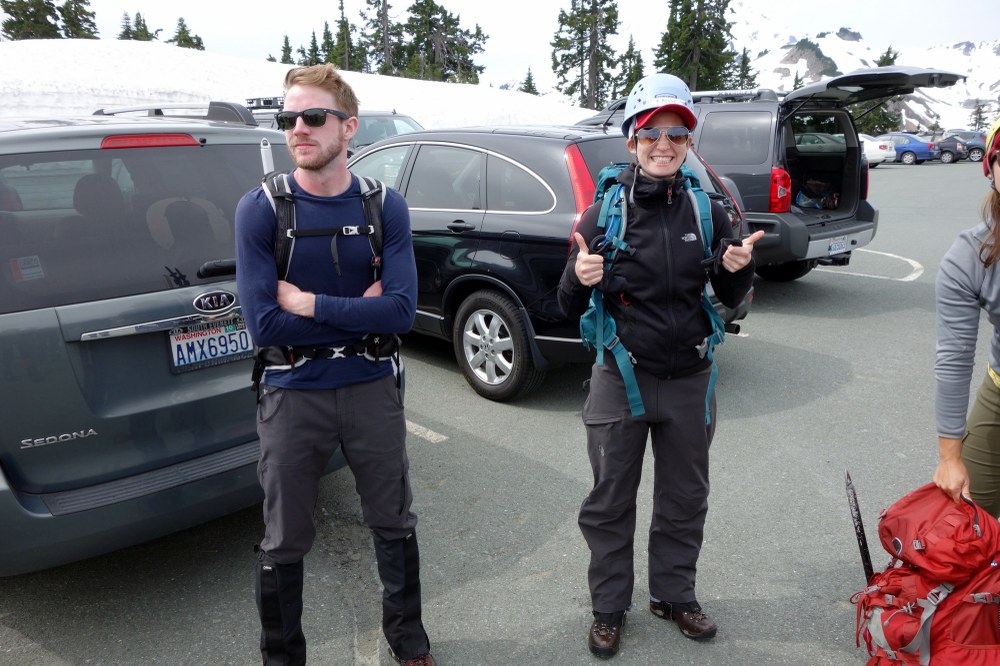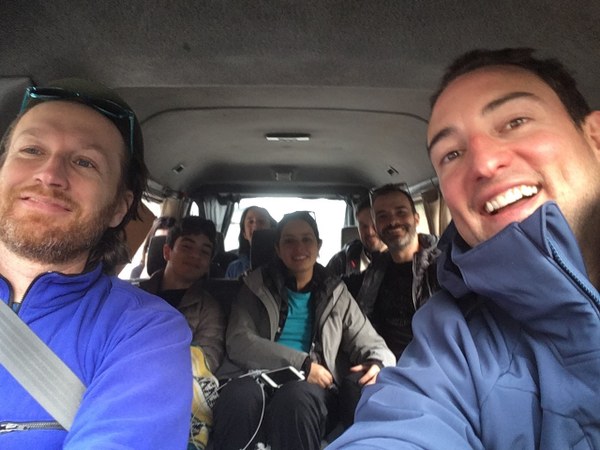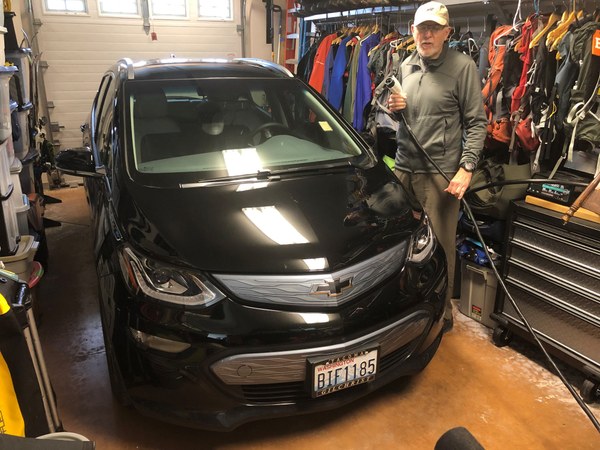
The Mountaineers made a commitment to reduce our organization’s carbon footprint as part of Vision 2022. In the Carbon Footprint Reduction Committee’s last blog post, we discussed the carbon footprint of food and what we can all do to make a difference. This month we’re excited to talk about another area where The Mountaineers, and most of us, can reduce our carbon footprint: transportation.
As Mountaineers, if we are going to paddle seas, climb peaks, and walk through the forests we love, we need a way to get to these places. As conscientious outdoor enthusiasts we should carefully consider the carbon footprint created by transportation.
Transportation is a big source of carbon emissions: according to the EPA, it’s the biggest. Transportation emissions come in large part from passenger cars and light duty trucks (including SUVs, pickups, and minivans) on the road.
If you’re like me, your household likely drives one or more vehicles on a regular basis. I love my little 4x4 van - it helps me feel connected to new places and to my past. I’ve lived in a van and traveled throughout the Americas in it with my family to visit many beautiful places and interact with wonderful people. But we were spewing diesel fumes all along the way.
In time, I found a few tips to reduce my own carbon footprint behind the wheel:
- If you’re a weekend warrior like me, consider doing fewer trips, but staying out longer if your employment allows. I joined The Mountaineers to explore and conserve lands where roads don’t exist, and by doing multi-night trips, I get to spend more time in those places.
- If you’re craving a day trip, consider choosing something closer to home. Sometimes I like to find the closest hike that I’ve never done. I’m often surprised by what’s nearby.
- Before COVID (and hopefully someday soon on the horizon) I enjoyed carpooling, sometimes filling my 8-seat van. It’s a great way to get to know other Mountaineers, or spend quality time with friends and family. I can’t tell you how many deep conversations and goofy singalongs I’ve had in a car full of people. It’s just fun.
- Keep those tires pumped up and take off the roof rack unless absolutely necessary. Friction, whether from low tire pressure on the pavement or in the form of wind resistance, is the enemy.
New technology has improved the carbon footprint of some personal vehicles. Today you’ll find hybrids that extend the range of gas engines, and electric vehicles that will never need an oil change. And cars aren’t the only way to get around. Below, a few of our committee members answer questions about their favorite modes of transportation and solutions to reducing their carbon footprints.
What reservations, if any, did you have about switching from your prior mode of transportation?
Erika Lundahl, electric vehicle owner: I thought that the electric would limit where I would go. But in some ways, it opened up more side adventures, and made me more excited to plan trips. I've found it's fun to try and see what attractions are near charging stations. It's introduced me to new restaurants, funky small towns that I always just shot by before, and more!
Jim Burke, electric vehicle owner: My biggest reservation about switching from a gas car to an electric car was range anxiety: how far could I drive before I ran out of electricity?
Nate Brown, carpooler: If it was someone I didn’t know, my biggest concern was whether I’d get along with them or not. It sounds kind of shallow, but a couple hours in the car on the way to the mountains with someone you don’t like can feel like forever and ruin a good time. I have to say though, that’s never happened. I usually carpool to the mountains with people I know, but the times I’ve done Mountaineers outings with new people, we got along just fine.
nate brown carpools with friends and family to stevens pass. photo by nate brown.
What made you make the switch to your new mode of transportation? What do you like about it?
Erika: I switched transport in order to save money, and because it aligned with my values to try and lower my carbon footprint for a livable planet. As someone who is low income, I've saved so much money on fuel and repairs with my electric car, which has fewer moving parts.
Nate: I started carpooling with my friends as a way to extend the trip in a way - I got to spend more time with them. Also because more and more the trailhead parking lots are packed, it seemed ridiculous to meet my friends there, each person or couple with their own car when we could all just pile into my van. It doesn’t get the best gas mileage, but it’s a lot less than three other vehicles on the road!
How do you plan for an electric car (or biking or carpooling) outing?
Erika: I use one of a few different handy apps. If I'm going to the mountains, or to visit family down in Oregon and I know the trip will be beyond my car's range in total (I drive a Nissan Leaf with about 100 mile range), then I use one of my apps - PlugShare or EZ-Charge usually - to see what might make for a logical stopping place. I try to pick charging locations where I can charge with at least 20% still left on the battery. It's easy, and gives me a chance to stretch my legs in the middle of a long car ride.
Jim: There are several factors I take into consideration. The first four are the total distance I will be driving, how much of that distance will be freeway driving (i.e. 60 mph or higher), what the outside temperature will be, and how much of my driving will be at night. All these factors affect how much electricity I need to use to cover that distance. Next, I use the app PlugShare, which lists all of the charging stations in the United States, to figure out the available opportunities to charge along my route and at my destination. I plan the primary charging stations as well as backup stations I will use on the trip.

Jim burke charges up his electric vehicle in his garage for his next adventure. Photo by Jim burke.
What advice do you have for others thinking about making a switch to an electric vehicle?
Erika: Go test drive an electric vehicle or borrow one from a friend. Think about how much you use your car for around town travel verses for longer trips. And take a look at where there are charging stations in your region. But honestly, my biggest piece of advice is to just do it. Electric vehicles are not just the way of the future, they are the way of the present. We have to transition away from a fossil fuel economy and the vehicles to make that possible are here now. Of course, we should all bike and take public transportation, and share vehicles as well. Electric cars won't solve our climate crisis. But it's one piece - and they really are a bunch of fun to drive and adventure in!
Jim: My advice for others thinking about buying an electric car is to first educate yourself. Go for a ride in a friend’s electric car. Ask them to let you take a short test drive. Ask them about their experiences, good and bad. Go for a test drive at a dealership. Consider all of the options, leasing an electric car, buying used, and finally buying new. If you decide to get an electric car, start saving up. My best bet is that you will never look back but you may ask yourself why you waited so long.
Nate: Pick a carpool partner who is reliable. I have very good friends I’ll go on adventures with, but I wouldn’t carpool with them because they can’t commit to timeframes for various reasons. Proximity is certainly a factor, proximity to you or to your destination. If you’re unsure about carpooling with someone new, I suggest having a third person you know in the car. My wife and I have done this and ended up meeting a really cool fellow Mountaineer who lived two blocks from us! Also, check out the resources on The Mountaineers website. You can set your carpool preferences in your member profile - a good resource when looking for carpool partners on Mountaineers outings.
For more information about electric vehicles and carpooling, check out the following articles:
Good Carpooling Practices: A how-to guide for carpooling with The Mountaineers, including carpooling best practices, how to arrange carpools, carpool etiquette, reimbursement rates, and park and ride information.
Footprints: Hiking vs. Carbon: In this piece from Mountaineer magazine, learn about electric vehicle use and how it has fit into the life of a family dedicated to getting outdoors.
Finding Family in the Passenger Seat: A Car-Free Journey to Community: In this piece from Mountaineer magazine, we hear the story of Ananth Maniam - a backpacker, climber, immigrant, and passionate advocate for car-free travel.
main image: mountaineers intense basic class.
Add a comment
Log in to add comments.Facebook group for adventuring by EV: EV Adventuring
 Nate Brown
Nate Brown
